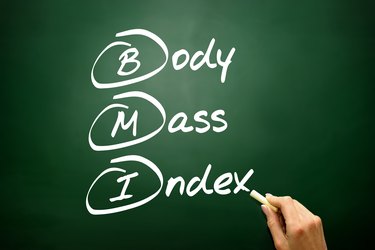
Although body mass index and body fat percentage tend to be related, BMI -- a calculation based on height and weight -- doesn't necessarily accurately predict a person's body fat percentage. There are equations you can use to turn your BMI into an estimate of body fat percentage, but to get a true measurement, you'll need to use another method to actually measure your body fat, rather than relying on a measurement based on your height and weight.
BMI as a Measure of Body Fat
Video of the Day
Body mass index is an easy and inexpensive way to estimate whether someone is at a healthy weight for her height, but it doesn't measure body fat directly. It's calculated by taking your weight in pounds and dividing it by your height in inches squared, and then multiplying by 703.
Video of the Day
BMI = weight in pounds / (height in inches x height in inches) x 703.
Those with a BMI of 25 or higher are considered overweight, and those who have a BMI of less than 18.5 are considered underweight.
BMI tends to overestimate the body fat of people who have large frames or a lot of muscle and to underestimate the BMI of women, older adults and those who have small frames. Male athletes tend to have lower body fat -- 6 to 13 percent -- while the average male has between 18 and 24 percent body fat, for example. The same is true in women, with athletes having body fat percentages of 14 to 20 percent, and the average woman having a body fat percentage of 25 to 31 percent. A study published in the American Journal of Clinical Nutrition in 2012 noted that the body fat ranges that are associated with different BMIs vary quite a bit. A man with a BMI of 25, which would be considered overweight, might have a body fat percentage of anywhere from 22.6 to 28 percent, and this BMI might be associated with a body fat percentage of anything from 35 to 40.2 percent in women.
Conversion Formulas
A study published in the International Journal of Obesity and Related Metabolic Disorders in 2002 compared four different formulas for converting BMI into an estimate of body fat percentage and came up with what the authors determined may be a more accurate formula. This formula states that adult body fat percentage is equal to (1.39 x BMI) + (0.16 x age) - (10.34 x gender) - 9, with gender equal to 1 for men and 0 for women to account for the lower body fat percentage of men.
Problems With Converting BMI to Body Fat
The problem with this equation and other similar equations, however, is that if you graph the results, it forms a straight line, but if you graph the actual BMIs and body fat percentages used to come up with the formula, they form a curved line. This means that the equation is more accurate for people of average body fat than for those who have more or less body fat than average. It may overestimate the body fat of men with high BMIs, for example.
More Accurate Measures of Body Fat
Taking skinfold thickness measurements using calipers is one of the less expensive ways to measure body fat, but the accuracy depends on the skill level of the person taking the measurements. Among the most accurate ways to measure body fat are dual-energy x-ray absorptiometry and underwater weighing, but these are expensive and not typically available to the average person. Some scales use a simplified version of bioelectrical impedance to measure body fat with varying levels of accuracy, but having a bioelectrical impedance test done by a trained professional is a more accurate body fat test.
- Centers for Disease Control and Prevention: About Adult BMI
- American Council on Exercise: What Are the Guidelines for Percentage of Body Fat Loss?
- Halls.md: My Favorite Heritage
- International Journal of Obesity: The Effect of Sex, Age and Race on Estimating Percentage Body Fat From Body Mass Index: The Heritage Family Study
- Psychology Today: What Does BMI Tell Us?
- American Journal of Clinical Nutrition: Percentage of Body Fat Cutoffs by Sex, Age, and Race-Ethnicity in the US Adult Population From NHANES 1999-2004